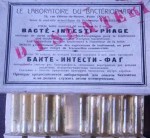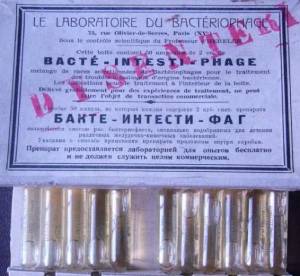
 Bacteria-Intesti-Phage, Virology (credit Laurent Debarbieux).
Bacteria-Intesti-Phage, Virology (credit Laurent Debarbieux).
The news of 2020 implies that we are all aware of the existent relations, particularly pathogenic ones, between viruses and humans. Fortunately, and unlike SARS-CoV-2, most viruses are far from sharing this attraction towards us, the rest of animals or even other multicellular beings. Thus, there are bacteria-eating viruses.
A bacteriophage virus has specific relationships with a species or bacterial strain. Phages can destroy their target bacteria (called “lyse”), which gave them their name (from ancient Greek bacteria + phageîn: “bacteria eaters”), but these relationships can take different forms and are the results of a co-evolution that goes back to the origin of life. Their discovery is, depending on the perspective, somewhere between the very end of the 19th century and the 1910s.
In a laboratory, these viruses have played and still play a major role as a research tool in biology. By studying the replication processes of bacteriophages, the work of the North American group «Phage» is, around the 1940s, at the origin of many discoveries in molecular biology and genetics. Today, bacteriophages are frequently used in experiments to cause targeted changes in the bacterial DNA. However, the original use of bacteriophages is medical. In this context, phages are used for their ability to selectively destroy bacteria that are pathogenic to us.
Phage therapy is developed in the 1920s around the tutelary and mythical figure of Félix d'Hérelle (1873-1949), a self-taught Franco-Canadian microbiologist with an exciting life. Worldwide, there is considerable scientific and therapeutic interest in this therapy. This results in the implementation of numerous clinical tests and the marketing of products, such as the “pyo-phage“ of the Laboratory of Bacteriophage, against infections with P. aeruginosa (bacterium specialized in opportunistic infections) or the "Ruhr-Bakteriophagen" by Bayer, against dysentery.
At the turn of the Second World War, the discovery and the massive use of antibacterial chemical agents (sulfamides then antibiotics) caused the phage therapy to fall into oblivion. In France, phages become a compassionate treatment, used as a last resort, in case other therapeutic strategies fail. Only the countries of the Soviet bloc, in particular Georgia, maintain a routine production and use of phages.
The fall of the USSR and the economic and political instability that followed, nonetheless, jeopardized the sustainability of its medical institutions, weakening once again the survival of phage therapy. It was during this same period that the risks associated with microbial resistance to antibacterial agents were elevated to a global public health issue. With communication campaigns well anchored in the collective imagination, antibiotics stopped being perceived as a miracle cure for any harmful microbe. This context renewed interest in phagic therapy, as an alternative solution against antibiotic-resistant bacterial infections. It is in this current context that academic teams and start-ups, mainly European and American, try to create the legal, productive and scientific conditions for sustainable and legitimate use of phages.
The latter are still difficult to integrate into a private mode of production. Big Pharma is reluctant to invest in a therapy where the possibility of patenting (and thus generating profits) is ambiguous. The academic path, relying on the "tailor-made" production of therapeutic products within a hospital, is one of the possible solutions. It is also difficult to integrate phages into the preferred form of biomedical evidence production, i.e., double-blind randomized clinical trials. Clinical evaluation of bacteriophages is a recurring controversy in the history of therapy. Beyond the question of the real effectiveness of treatment, these debates are useful to highlight the evolution of evidence-delivery practices in biomedical sciences.
“Living” products, both ubiquitous and specific, easy to produce, but difficult to handle, with an intuitive but challenging mechanism, bacteriophages are a prolific source of reflection for researchers in the human and social sciences. In anticipation, perhaps, to become common medical practice again.
Read more in the dictionary : Truth serum - Stomach
Read the paper in French : Thérapie phagique
Références :
C. Summers, Félix d'Hérelle and the Origins of Molecular Biology, Yale University Press, 1999.
Brives, J. Pourraz, "Phage Therapy as a potential solution in the fight against AMR : obstacles and possible futures", Palgrave Communications, 2020, vol. 6.
To quote this paper : Thomas Bonnin, “Phage therapy” in Hervé Guillemain (ed.), DicoPolHiS, Le Mans Université, 2022.